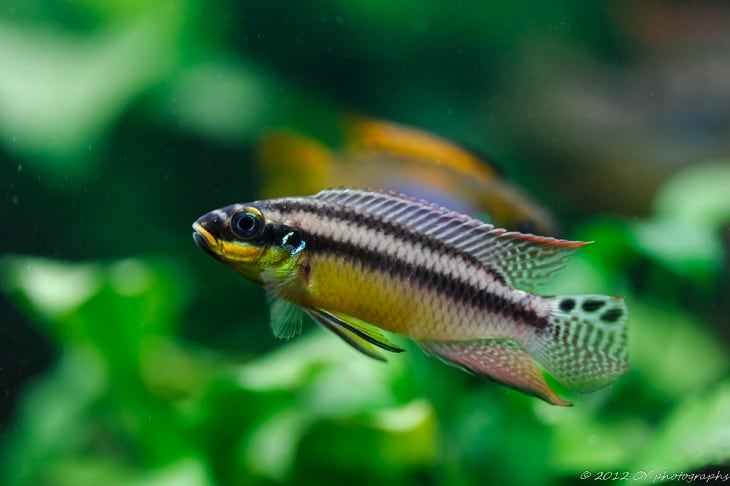A number of years ago, my son reintroduced me to the aquarium hobby. He already had a set-up in his apartment and dragged me to a meeting of the Diamond State Aquarium Society. I dont remember what the topic was that night, but the people at the meeting were friendly and more than willing to answer any of my simplistic questions. From that first meeting, I got hooked like a fish (sorry).

After listening to some of the society members’ talk, I decided I didn’t want to just set up an attractive tank but to try and raise and breed a given species. I went out and bought two twenty-nine gallon tanks. One I set up in an Amazonian habitat loaded with a variety of tetras and a few Cory cats. The other I set up with eight young high-fin veil-tail angels. The exploits of my attempts and final success in getting these angels to breed, I wrote about in a previous article.
This writing is to tell you about my experience with a small cichlid called The Rainbow Dwarf Cichlid or Krib, known in scientific circles as Pelvicachromis pulcher or in past times Pelmatochromis kribensis. (B. Smith take note). These are West African dwarf cichlids. The Latin term pulcher means beautiful and that they are. This small cichlid is peaceful, colorful and well suited to a 10-20 gallon tank. Not only that but they spawn easily and the parents care for the fry. They are adaptable to varying water conditions but do best at 72-76o F. with a pH between 7.0 and 7.6. A small gravel substrate in recommended since the adults dig pits for spawning. Kribs should be provided with some form of cave for their spawning. With a good varied diet they will be able to spawn at 6-8 months.
At the DSAS meeting’s auction, my son purchased a pair of kribs; he, however, hadn’t a place for them and asked me to keep them in one of my tanks. By this time I had acquired a few extra tanks, including a fifty-five gallon in which I placed the pair of kribs along with some young angels. One week later, the pair had dug a hole in a corner of the tank under a rock, and had deposited eggs on the tank glass. I watched in fascination as the adults stood guard over the clutch and took on all of their tank mates that came to close. Sad to say, after four days the eggs were gone.
I waited a few days and transferred the pair of kribs to another tank I had set up for them. This was a ten-gallon tank with gravel bottom, corner filter and a three-inch flowerpot surrounded with slate to form a cave. The pH was neutral (7) and the water soft; temperature was 75 degrees Fahrenheit. The pair took up residence in the cave after exploring their new domain. I alternated their feedings between flake foods and frozen brine shrimp. The pre-spawning behavior seems to be initiated by the female; she is the more brightly colored with her abdomen appearing a rosy red. After three days of the pair checking out all the possible spawning sites in their tank, I was rewarded by the pair depositing eggs on the glass behind the filter. (So much for caves). The pair stood guard with the female constantly fanning the eggs. Three days later the eggs were gone; I assumed the adults had eaten them. Great breeding technique!
But wait! Five days later while feeding the adults I noticed movement in the flower pot cave. And what to my wondering eyes did appear? Fry, about twenty, 1/4 inch long, light tan with dark spots. Boy, am I a great fish breeder or what? I immediately added some infusoria and set to hatching brine shrimp. I fed the fry with a combination of microworms, brine shrimp nauplii, and very finely ground flake food. The fry grew rapidly. I left the adults with the fry, and watched as the female herded her brood around the tank and got them in the cave at the slightest sign of danger (me). After three weeks the fry could be seen wandering around the tank on their own. Since the adults were not needed and seem to have lost interest I removed them from the tank.
I have gotten the pair of Kribs to breed many times since that time, most of the time in a 3 flowerpot laid on its side. This shy little cichlid makes an excellent starter cichlid for anyone interested in breeding egg layers. It’s attractive coloration, small size (2 1/2 – 3 inches), non-aggressiveness, and fair tolerance of water conditions make it an amateur’s dream.
Leave a Reply